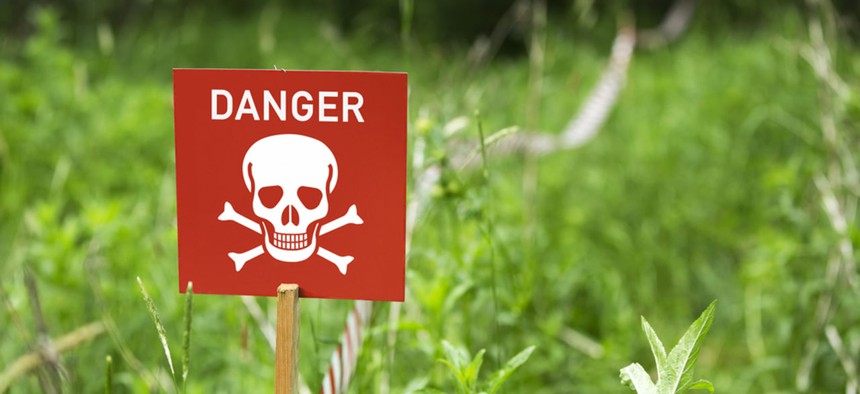
LeStudio/Shutterstock.com
How to Spot Toxic Employees Before You Hire Them
Managing a toxic employee is difficult enough. Weeding them out during the hiring process can be an even more difficult challenge.
When people on a team work well together, exemplifying positivity and a willingness to listen and grow, it’s like hitting a productivity jackpot.
Some forward-thinking companies have even gone so far as to revamp their entire interview practices to put more emphasis on teams, recruiting groups over individual hires, precisely because people who work well on teams are, in general, the type high-performing employees that companies want to keep.
But there’s another type of team member—one who can derail employee productivity and happiness along with company profitability: the toxic employee. While no HR manager ever sets out to hire one, toxic employees drain otherwise positive workplaces.
The cost of a toxic employee
Hiring a toxic employee has a significant impact on everything from day-to-day workplace dynamics to the long-term bottom line. Research shows that employees are 54% more likely to quit when have a toxic coworker. And can you blame them? No one wants to come to the office to be bullied, unjustly blamed for the failures of others, or involved in avoidable drama created by a co-worker who thrives on it.
Margins suffer, too. According to one survey, hiring just one toxic employee into a team of 20 costs a company approximately $12,800in employee turnover and decreased productivity, among other factors. Compare that to a non-toxic hire, which costs only $4,000.
Echoing the extent to which toxic employees affect profit, research on civility at work indicates that rude employees have a stronger effect on organizations than civil ones do. So, even a team of rock stars won’t be immune to the havoc that comes with a toxic worker.
How can you spot a toxic employee? Chances are that if you work with one, you know. In general, toxic employees are aggressive or defensive with coworkers, resistant to change or growth, and unwilling to take responsibility for mistakes. They might be overt bullies, or they might gossip quietly about you behind your back. Regardless of how their behavior manifests, the result is the same: a workplace culture that’s charged with negativity and inefficiency.
Screening for toxic employees when hiring
Managing a toxic employee is difficult enough. Weeding them out during the hiring process can be an even more difficult challenge. Some people are good on paper and perform well in interviews. Their toxic qualities only come out once they are engaging with coworkers, handling challenges, or working under pressure, which is why honing your hiring process to spot troublesome signs early is key.
Interviewers and hiring managers need to “be on the lookout for signs of civility,” as leadership expert Christine Porath puts it. Ask candidates about previous experiences rather than engaging them in hypotheticals. So, for instance, rather than asking someone how they would handle a difference of opinion with a co-worker, ask for specific examples of how they’ve resolved conflicts in the past.
Most people, especially seasoned candidates, come to interviews having prepared a stock answers. When you ask a question, don’t settle for a rehearsed or overtly trite response. Ask for multiple examples of how they handled different personalities and dynamics in the workplace. By asking them to dig deep, you’re likely to get answers that are more honest, more spontaneous, and more indicative of their potential for toxicity.
Some of these questions may seem unconventional, but they’re designed to predict whether an employee will be a positive addition to a team or whether they’re more likely to cause problems.
Try asking:
- What would you change about your previous job?
- What would your former employers say about you? List some positives and negatives.
- What has been your biggest professional success so far, and how did you achieve it?
- Talk about some instances when you had to manage stress at work. What did you do?
- Discuss a few times when you found it difficult to work with someone. How did you approach the situation?
No workplace is perfect, and many of these questions require candidates to speak to the negatives. Ideal candidates, however, will present problems without pointing fingers at people, shaming others, or playing the victim. Candidates who complain or gripe about their supervisors, co-workers, or direct reports are likely to exhibit similar toxic qualities in other contexts.
Sometimes, it comes down to a gut feeling. If you’re interviewing someone and feel unsure about them, call their references. You can also call people they supervised, or people in your network who may be mutually connected. Have them interview with colleagues with whom they’ll be working or even spend a day around the office to get a feel for how they mesh with the rest of the team. If your gut feeling is confirmed, the extra mile was worth it.
The importance of psychological safety
In an age where innovation is essential to thrive, you can’t afford to have a team that’s fearful of open communication, vulnerability, and healthy conflict. After all, some degree of friction is needed to spark growth.
Prioritizing psychological safety—assuring employees can take risks without feeling insecure, embarrassed, or criticized—is the most important attribute a team can have. But once a toxic employee joins the ranks, it’s very hard for people to do their best work.
It’s the responsibility of leaders at companies to screen for toxicity when hiring and build psychologically safe workplaces. When they do this successfully, good employees are more likely to stay, grow, and take risks, which propels everyone forward.
Melody Wilding is a high-performance coach, writer, and speaker.






